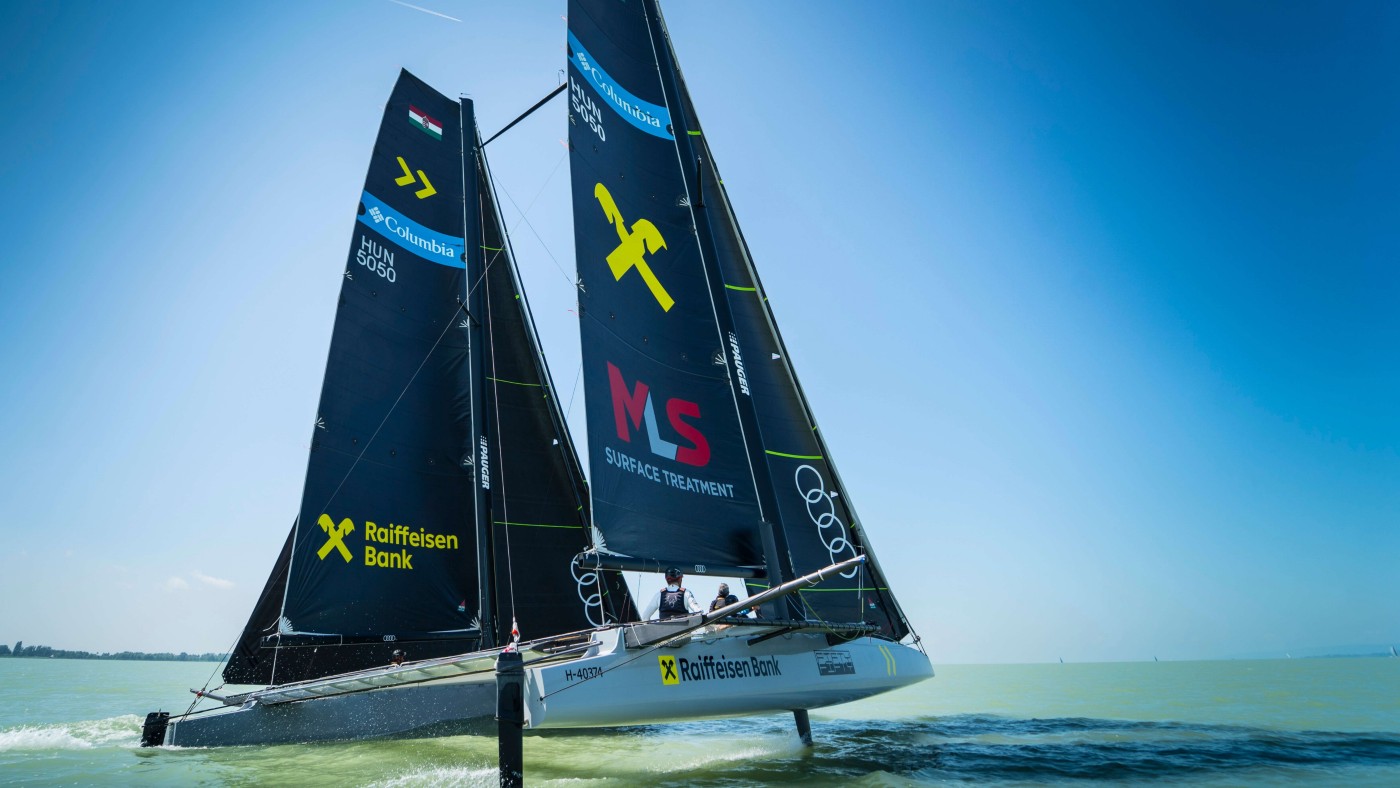
Hungary: Resilience, Innovation, and Social Impact in Uncertain Times
What kind of complex challenges is the Hungarian economy facing right now and what will the future bring? Get all the details in an in-depth analysis by István Ferenc Ágoston, Head of Financial Institutions and Custody at Raiffeisen Bank Hungary. Find out why innovation is a key-factor in tough times and read everything about our latest payment solutions. PLUS: Discover what values RB Hungary shares with sailing, handball, and opera in our interview with Veronika Yalcinkaya, Head of Marketing and Communications at Raiffeisen Bank Hungary.
Economic Outlook for Hungary: Everything you need to know
Negative growth in 2025 Q1: In the first quarter of 2025, the Hungarian economy is grappling with stagnation and contraction, continuing a trend that started mid-2022. Key indicators showed a 0.2% quarter-on-quarter and a 0.4% year-on-year GDP-contraction. This marks the sixth contraction in the past twelve quarters, underscoring the persistent weakness of the Hungarian economy.
Weak demand in manufacturing industry: The ongoing difficulties in Germany—Hungary’s key trading partner—were a major factor behind the weak demand for Hungarian manufacturing products. Industrial production declined by 4.5% year-on-year in the first four months with only a modest 1.5% monthly uptick in April. The outlook is for slow, gradual growth in the second half of 2025 (expected full-year contraction: 2.5%) and a more pronounced 4.5–5% growth in 2026.
Construction sector in the doldrums: The construction sector continued to struggle, with output 4.3% below the previous year’s level in the first four months. Housing construction remained weak, with a 2.7% decline in Q1. Industrial and logistics investments fell sharply. State infrastructure projects may gain momentum later in the year ahead of the April 2026 elections. Despite a slight annual increase in the second half, a 2% decline is forecast for the full year. In 2026, the sector may benefit from renewed investment in infrastructure and housing.
Service sector is the only bright spot: The services sector provided some stability, growing by 1.1% year-on-year in the first quarter, led by education, arts, leisure, and healthcare. Trade, hospitality, and logistics also expanded, although growth slowed or stagnated in some areas due to poor demand. Tourism performed exceptionally well, particularly with international guests, and the sector is expected to grow by about 2% in 2025.
Investments are down big time: Investment activity was the weakest area of the economy, with volumes down 12.1% year-on-year in the first quarter. Manufacturing and transport were the main drags, while real estate and energy provided partial offsets. State and EU-funded investments remained subdued, and private sector investment appetite was weak. No significant improvement is expected in the first half of 2025.
External balance is challenged by tariffs: In the first months of 2025 Hungary’s external balance was broadly stable but showed slight deterioration. Imports outpaced exports, narrowing the trade surplus. The services surplus declined due to weaker demand for transport and business services. The current account stayed positive, and external debt stabilized at a high level, with an increasing share in foreign currency, raising vulnerability. US tariffs pose risks to the export-oriented automotive sector (affecting regional hubs like Győr and Kecskemét), with potential spillover effects on pharmaceuticals and agriculture.
Public budget with deficit overshoot (again): Public finances faced considerable strain. By the end of April, the budget deficit reached HUF 2,930.5 billion (over 70% of the annual target), one of the worst four-month results in years. While revenues were on target, EU funds lagged far behind expectations. Overspending—especially on debt service, public wages, and utility subsidies—drove the deficit. The budget deficit could rise to about 5.5% (in GDP %) as opposed to 4.5% government target.
Inflation target is out of reach: Inflation remained elevated, at 4.4% in May, above the central bank’s 3% target. Food and service price growth slowed, helped by government measures such as price caps, margin reductions, and targeted subsidies. Inflation is expected to remain above 4%. The Hungarian National Bank maintained a cautious, stability-focused policy, keeping the base rate at 6.5%, expected to remain until mid-2026. The forint exchange rate stabilized against the euro (400-410) and strengthened against the dollar.
Modest growth in 2025, hope for recovery in 2026: Looking ahead, the Hungarian economy is expected to see only modest growth in 2025—between 0.5% and 1%—with a possible acceleration to 2.7% in 2026, provided external demand improves. However, structural weaknesses, especially low investment, high external dependence, and fiscal pressures, remain significant challenges for sustainable growth.

New For You: Cutting-Edge Payment Solutions
Amidst these economic challenges, Raiffeisen Bank Hungary is at the forefront of innovation, offering state-of-the-art payment solutions that empower customers to operate swiftly and efficiently. Here is what’s new.
Mobile Payment Solutions: Raiffeisen Bank introduces the Qvik brand, featuring advanced mobile payment services powered by the Instant Payment System. This system allows for domestic electronic transfers of up to HUF 20 million to be completed within just 5 seconds, 24/7. Qvik offers three convenient payment methods: QR code payments, NFC-based payments, and Deeplink-based payments. Benefits include competitive pricing compared to traditional credit card transactions, instant availability of incoming funds in your account, one-click transfers, and automated transaction processing.
Streamline payments: Our Request to Payment solution simplifies transfers by allowing payees to request immediate payments from customers, complete with real-time status updates. This enables quick and error-free transactions without extensive banking software. For example, insurance companies have effectively reduced the rate of unpaid premiums.
Easy and cost-efficient corporate finance: The Raiffeisen Payment API automates transfers directly from your ERP or invoicing system to the bank, ensuring immediate processing of approved payments. This 24/7 service features secure authentication and automated signature verification.
Stay up to date: With our direct link to account activity, you can monitor debits and credits in real-time. Instant notifications allow for automated reconciliation of invoices and incoming payments, even on bank holidays, ensuring your financial operations run smoothly.
Simplify Accounts Receivable: The Virtual Bank Account Number is a unique solution for identifying partners who have settled their invoices. A single payment account can manage nearly 10 million unique virtual account numbers, streamlining the reconciliation process and eliminating the hassle of incorrect payment information.

Interview: Setting Sail for Social Impact – Our Journey in Community Engagement
Raiffeisen Bank’s mission, “A digital bank with a human touch,” perfectly sums up the company’s approach in a fast-paced, increasingly digital world. But how does a financial institution with over 130 years of history remain truly people-focused in the era of AI? We asked Veronika Yalcinkaya, Head of Marketing and Communications at Raiffeisen Bank Hungary, to share her thoughts.
We’re speaking during a particularly busy time for the bank. Recently, we saw the Raiffeisen Bank logo at the Elle Women of the Year awards, the finals of the European Handball Federation (EHF) Men’s and Women’s Champions League just wrapped up, and you’ve already announced your cooperation with the 57th Kékszalag Raiffeisen Grand Prix, a major sailing event.
It’s true — we’re right in the middle of an event-filled season. But honestly, when isn’t it busy? Besides the major partnerships you mentioned, we’re involved in many other initiatives as well. I feel fortunate that we have so many opportunities to connect with the society we’re part of.
It seems like sports play a central role in your activities?
Sports are indeed an important pillar of our sponsorship strategy, but our approach goes far beyond that. When we enter a partnership, we aim to support events that are internationally recognized and create value not just for athletes but also for young talent and fans across many countries.
That’s how we became involved with handball. This year, we were proud to sponsor both the men’s and women’s EHF Champions League for the first time. It carries a strong message for us: our customers see the Raiffeisen brand in a sport that Hungarian children grow up playing, a sport in which Hungary has achieved great success over the years. And it’s equally meaningful that we’re supporting both the men’s and women’s competitions.
While sports are a key focus, the bigger goal is to create positive social impact. We believe it’s our responsibility to choose partners that allow us to make a meaningful difference. That’s why we also have a strong presence in the cultural sphere — supporting institutions like the Hungarian State Opera and the Budapest Festival Orchestra — and we’re proud to back business initiatives too, such as Cápák között (the Hungarian version of Shark Tank), which has become a unique platform for entrepreneurship.
Which partnership are you personally most proud of?
It’s hard to choose just one! It’s always the one we’re most deeply involved in at the moment. Right now, we’re preparing for the 57th Kékszalag Raiffeisen Grand Prix, where Raiffeisen Bank has been the title sponsor for six consecutive years. It’s the most prestigious sailing competition in Hungary, deeply rooted in tradition. What makes Kékszalag truly special is that it not only showcases racing, teamwork, and the value of experience, knowledge, and good decision-making, but it also highlights innovation, technology, and digital progress—offering something new every year. And it all takes place on Lake Balaton, Hungary’s iconic lake, which represents nature and recreation for hundreds of thousands of visitors, both local and international. We’re proud of these seven years of partnership. In my view, the only way to be a credible supporter of a sport is to commit to it for the long term.
Do customers appreciate your efforts in social responsibility and sustainability?
Absolutely, yes. Naturally, customers’ top priorities are being able to manage their finances easily, quickly, and securely — wherever and however they prefer. Most of the time, that means online banking through mobile apps. But what makes us truly people-focused is that we’re also available in person whenever they need us.
Beyond our core business, our customers show us every day — through their loyalty and choices — that they value brands that not only serve them but also invest in the communities they’re part of.